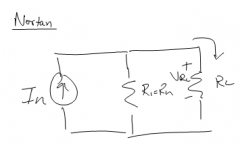![]()
![]()
![]()
Use LEFT and RIGHT arrow keys to navigate between flashcards;
Use UP and DOWN arrow keys to flip the card;
H to show hint;
A reads text to speech;
19 Cards in this Set
- Front
- Back
|
KCL
|
Sum of Currents at a Node must Equal Zero
|
|
|
KVL
|
Sum of Voltages in a Loop must Equal zero
|
|
|
Ohm’s Law
|
V=IR
|
|
|
Resistance Laws(Series)
|
Req = R1+R2+R3...+Rn
|
|
|
Resistance Laws(Parallel)
|
Req = 1/((1/r1)+(1/r2)+.....(1/rn))
|
|
|
Voltage Devider
|
Vn = (Rn/(R1+R2+...Rn))*Vs
|
|
|
Current Divider
|
in = ((1/rn)/((1/r1)+(1/r2)+....(1/rn)))*is
|
|
|
P(watt) =
|
V*I, = I^2*R = V^2/R
|
|
|
Current through a series Curcuit
|
current through one element must equal the current in the next
|
|
|
Voltage through a Parallel Curcuit
|
Voltage Through each element equals the other
|
|
|
Node Analysis
|
1. Select 1 node to be the reference
2. Mark the other nodes and label node voltages. 3. Mark the current direction & Polarity on R’s based on PSC, 4. Decide if any node voltages are known, 5. write a kcl equation for each node with an unknown voltage, 6. Express the currents in terms of node voltages i1-i2 = 0 (v1-v2/r1), 7. Gather Node Voltages together, 8. Solve for Node voltages. 9. Use node voltages to solve for other voltages/currents. |
|
|
When are Node voltages known?
|
When a Voltage source is connected to a refference node.
|
|
|
Mech Analysis
|
1. Mark Meshes & Lable mesh currents(will do clockwise in class), 2. Decide which mesh currents are known/unknown, 3. Write a KVL Equation for eash mesh with an unknown mesh current *assign Polarity on resistors based on mesh current of KVL Eqn. 4. Express Voltages in terms of Mesh Currents, 5. Gather up all of terms and solve,
|
|
|
When is a Mesh current known?
|
When a current supply is connected to only one mesh.(if it isn’t then both of the meshes are dependent.
|
|
|
Equivalent resistance
|
1. Remove the load resistor,
2. Clealy mark Terminal where the resistor was 3. zero all independent sources 4. "zero" means a wire over voltage sources and make current sources open 5.Find the equivalent Resistance between load terminals (This is Rn &Rt) *tips - redraw circuits if your having issues condensing |
|
|
Thevenin Circuit
|

|
|
|
Nortan Cicuit
|

|
|
|
Computing the norton Current
|
1. Replace the load with a short circuit
2. Define the short-circuit current i(sc) to be the Norton equivalent current 3. Apply any preferred method (e.g., node analysis) to solce for i(sc) 4. The Norton current is i(n) = i(sc) |
|
|
Computing the Thevenin Voltage
|
1. Remove the load, leaving the load terminals open-circuited.
2. Define the open-circuit voltage v(oc) accross the open load terminals. 3. Apply any preferred method (e.g, node analysis) to solve for v(oc). 4. The Thevenin voltage is v(t) = v(oc) |

